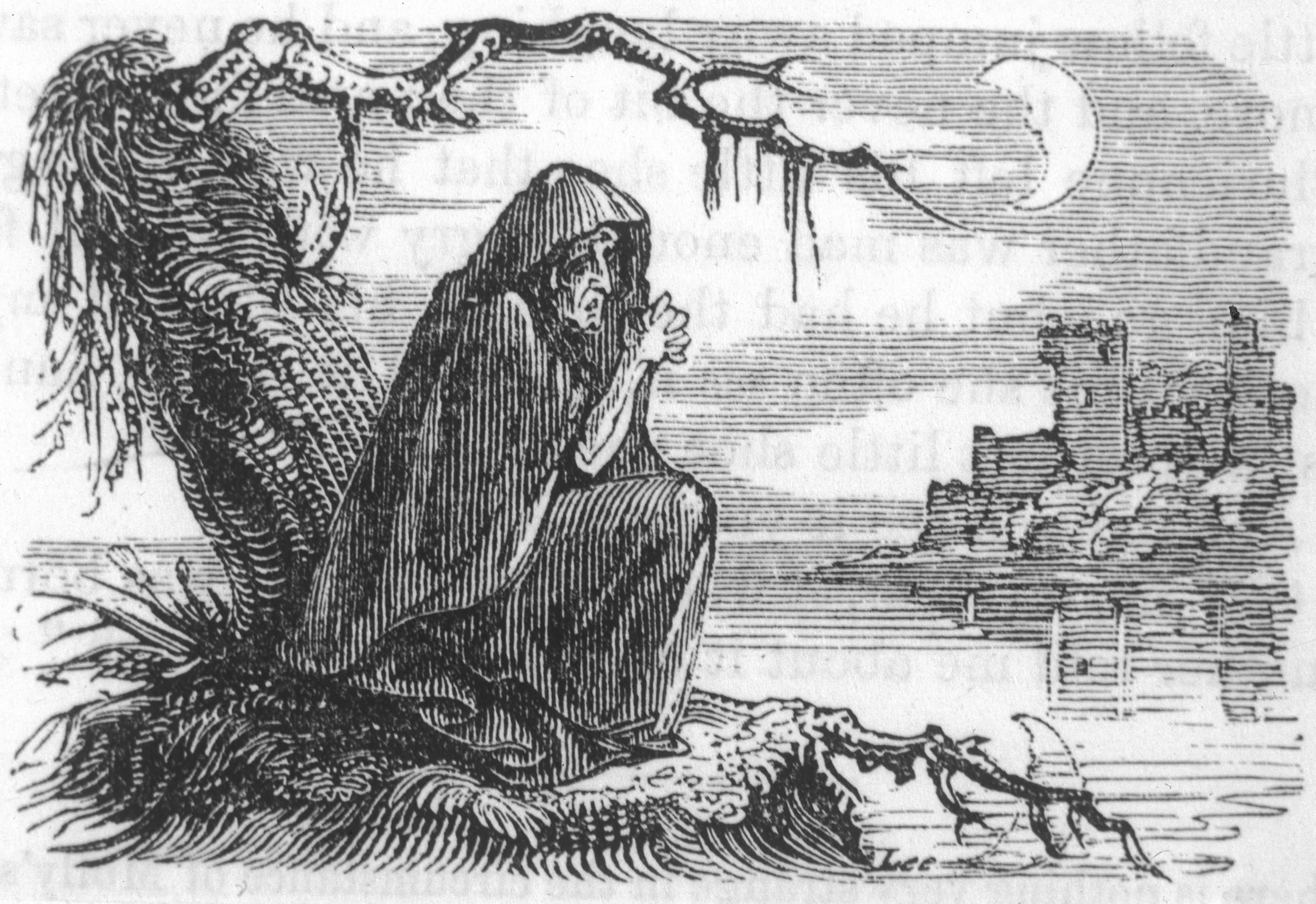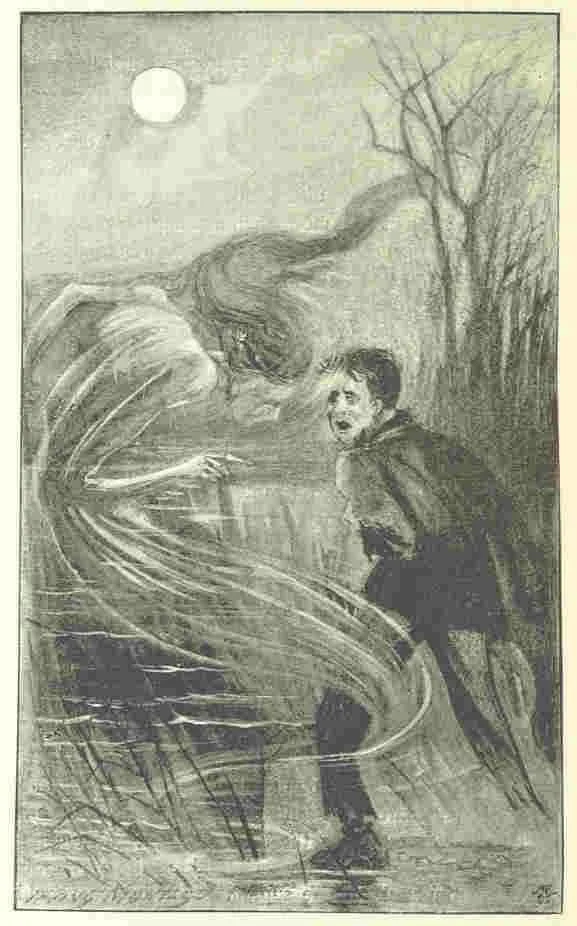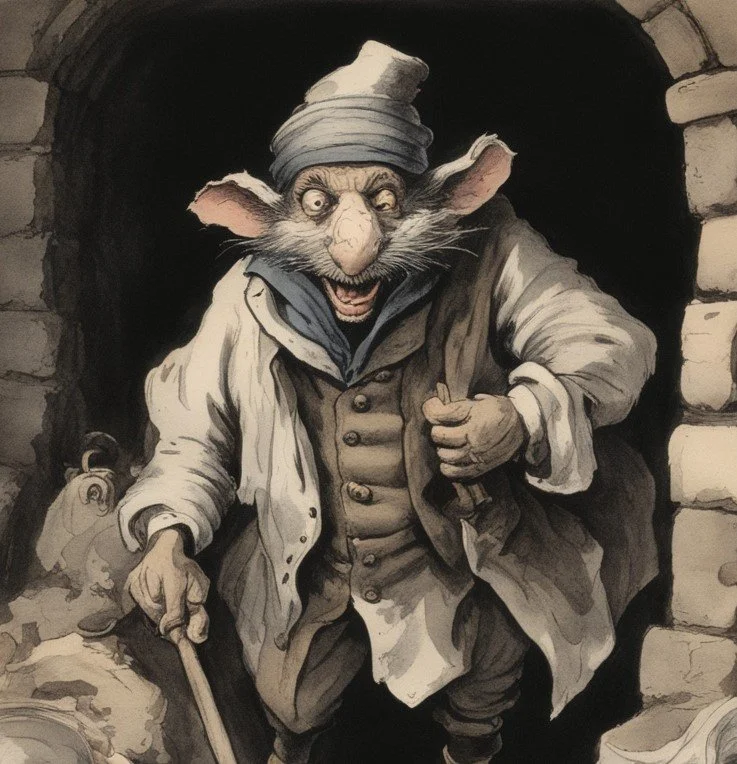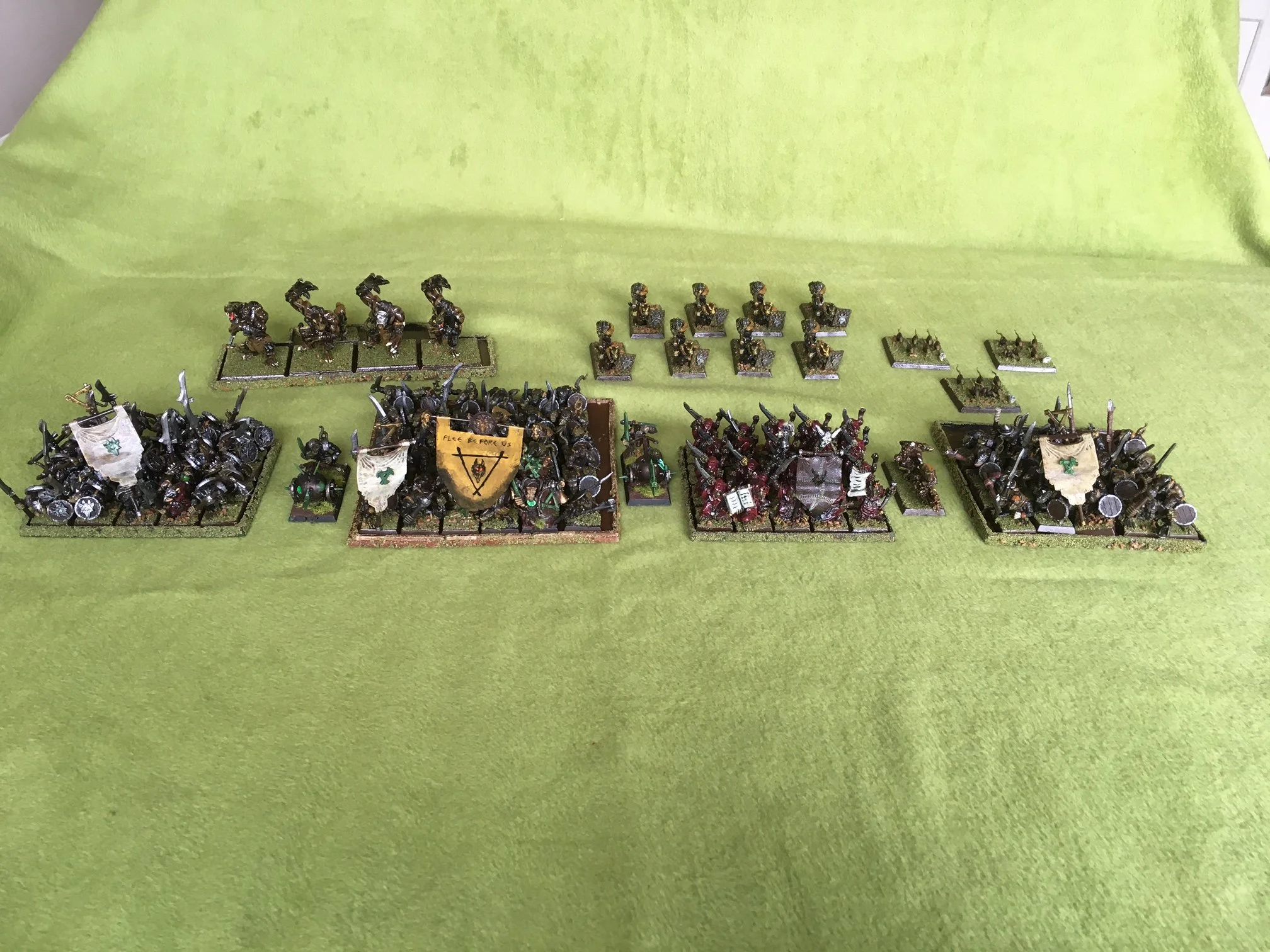Yr Hen Wrach - The Crone of the Bog.
Yr Hen Wrach - The Crone
Yr Hen Wrach (roughly pronounced - Err Hen rack) is a being from Welsh folklore, her name means means Crone. She was an elderly lady, now elderly ladies in folklore get a lot of bad press, usually they are portrayed as witches or Hags (a bit harsh, believe it or not my Nan is an elderly lady and she is lovely, more than willing to share her last Hobnob Biscuit with anyone.) But I digress, Yr Hen Wrach was most certainly not an old charmer. She lived in a place called Cors Fochno (Borth Bog), one of the largest unspoilt, raised mires in Britain. The Village of Borth lay nearby.
Yr Hen Wrach was a terrible Hag-like being, believed to stand nearly seven feet tall, and terrifying to behold. She haunted the treacherous wastes, appearing from the mist shrouded bogs to lure unwary travellers to their doom, definitely not the sort of person to share her last Hobnob.
When she was in a particularly bad mood, and when the mist spread from the marshland to envelope the village of Borth she would rise from the peaty depths to wander amongst the cottages, should she discover any unfortunate person out and about, she would breath on them, this would cause the poor soul to sicken, and in some cases even die! Naturally when the people of Borth saw the mists drifting in from the mire they would lock their doors and shutter their windows.
Borth Bog holds many other tales, it is believed to be the home of a Toad, said to be the second oldest creature on Earth. Alien Big cats are regulalry seen by local folk, there is also a submerged forest which can be seen at nearby Borth bay, with tree stumps dating back to 1500BC. It is said the ancient stumps are all that remain of the lost Kingdom of Cantre’r Gwaelod, a fertile land that was drowned beneath Cardigan Bay.
I hope you enjoyed this little exploration of Welsh Folklore. If you did you may like my book ‘Fireside Horror.’ The links are below, if you feel brave enough to purchase a copy.
#Folklore #Folkhorror #paulsheldon #Horror #welshmythology #welshlegends #horror #book #horrorbook #folkhorrorbook #myths #legends
The Curse of Tiddy Mun
A picture of the Tiddy Mun (though personally I think he looks a little on the tall side, and seems to lack a beard.)
The Tiddy Mun is a character from Lincolnshire Folklore. For those outside the United Kingdom, Lincolnshire is a county in the East Midlands, it is a relatively rural area made up of rivers, fens and rolling countryside.
Years ago Lincolnshire had a lot more wetland, but it was decided that this should be drained and turned into fields for farming. This is where The Tiddy Mun comes in. The Tiddy Mun meaning ‘The Small Man’ in the local dialect, was a sort of gnome-like entity with white hair and a long white beard that would have put Gandalf to shame. He was described as being three to four spans high (A span is the distance measured by a human hand, from the tip of the thumb to the tip of the little finger) I’m not certain how accurate a form of measurement this is so please don’t use it for any DIY, unless you like wonky shelves.
As his name would suggest the Tiddy Mun was small, he was the King of the Tiddy Folk (Fairy Folk.) If ever there was flooding the local folk would go about the district chanting -
Tiddy Mun wi’out a name
Tha watter’s thruff
Which means ‘Small Man without a name, the water’s through!’ The folk would then listen for the cry of a Peewit, if they heard the birds call they would know The Tiddy Mun had taken pity on them, and the waters would soon recede. So in this respect he was quite a helpful little chap. But he also had a dark side, if people in the area drowned or disappeared, it was said The Tiddy Mun was to blame.
When King Charles I, bought in Dutch engineers to drain the fens the old Tiddy Mun was a tad annoyed, and demonstrated his displeasure by causing houses to collapse, walls to crumble and disease to spread amongst the people and their livestock. (Strangely most of these unfortunate things could have been bought about by the dramatic change in the landscape.)
Facing these horrible disasters the folk went out and poured water into the local ditches chanting -
Tiddy Mun, wi’out a name,
Here’s watter for thee,
Tak tha spell undone!
The people continued this tradition for many years, until eventually it was supposed that the Tiddy Mun had vanished from the Fens forever.
So that is the story of the amusingly named ‘Tiddy Mun,’ if you enjoy Folklore why not try my book ‘Fireside Horror’ it has had very positive reviews, the links are below.
The Afanc
The terrible Afanc
The terrible Afanc is a water monster from Welsh mythology. He has many different descriptions, sometimes being described as a Nessie-like creature, while other times he is said to have a crocodilian form, others say he resembles a great beaver, and there are even descriptions of him looking like a gnome or goblin.
It was considered very unfortunate to have such a creature living close to your community, quite apart from its fearsome appearance (well maybe not the giant beaver one, which I can’t help but see as being rather sweet) its chief danger was believed to be the flooding it caused when it was angered, ruining peoples homes and damaging their valuable crops.
So if your community found itself close to a lake, river or pond, that was said to be home to one of these supernatural nuisances, the likelihood is that they would want to get rid of it. But that was easier said than done. Firstly anything described as a ‘monster’ has usually earned that name for a good reason, because it is unpleasant and probably rather dangerous. Secondly it was believed that feats of arms could not slay the beast, as its hide was immune to swords, spears or arrows.
Betws-y-Coed is a Welsh village in the county of Conwy, and many years ago they had a problem with an Afanc that dwelt in the local Conwy river, He was said to resemble a giant beaver (Now I have already spoken about my felling’s on the beaver versions, in short, I would probably have given the cute ‘furry fella’ a pass, but to be fair it is not my home he is flooding.)
The villagers designed a plan, if they could not slay the water monster they would lure it away. They got a rather brave, local maiden to sing sweetly by the river, luring the beast out of the water, and such was the power of the girl’s voice that the creature fell asleep at her feet. Quickly it was bound with great chains and then the pulled away by the villagers, it was taken to a lake under the summit of Yr Widdfa the highest mountain in Wales.
Its new home was Llyn Glaslyn - which means ‘lake of the blue spring’ and being high up in the mountains, and alone, with no one to hassle it, I imagine it lives quite a peacefully now.
So in the end everyone was happy.
A less pleasant version of an Afanc appears in my book ‘Fireside Horror,’ if you like folklore or enjoy creepy tales why not get a copy, links below.
The Erlking
The Erlking is an entity from European folklore, the word ‘Erlking’ comes from the German: Erlkönig literaly meaning alder-king. He is/was/maybe a lord of the forest and King of the Faeries. He was believed to lurk in ancient woodland, there he would stalk any unfortunate children who linger too long beneath the boughs of his realm, it was said he could kill mortals with a single touch.
The Name was first used in the poem ‘Erlkönigs Tochter’ (1778) by German romanticist Johann Gottfried Herder. The poem tells the tale of a boy being carried on horseback by his father through the night, the purpose of their journey isn’t explained, I can only imagine that it was an urgent one. As they travel the boy becomes fearful, complaining that they are being followed by an unnatural being. The father, clearly a sympathetic man, totally dismisses his sons complaints, putting down the odd sights and sounds to nocturnal shadows, and the wind in the trees. I don’t know about you but I have a feeling this ‘father of the year’ will come to regret this!
As they continue their journey, The Erlking tries to lure the boy using riches, clothes and his daughters, I have no idea whether the poor daughters agreed to be bait, and if they didn’t I can only hope they fully expressed their disproval when they next get together for a family dinner. Finally a little bit annoyed, the Erl-King declares his intention to take the boy by force (I suppose at this stage his thinking ran something like this; If I’m going to have an ear-bending at the hands of my irate daughters, I might as well have something to show for it.)
When the father finally arrives at his destination he finds that his beloved son is dead!
So a bit of a grim poem really, but an entertaining one never-the-less, The ‘new Oxford American Dictionary describes the Erl-king in the following way: a bearded giant or goblin who lures little children to the land of death.
Anyway here is a translation of the poem from German, by Edgar Alfred Bowering. Hope you enjoy it, stay spooky.
Who rides there so late through the night dark and drear?
The father it is, with his infant so dear;
He holdeth the boy tightly clasp'd in his arm,
He holdeth him safely, he keepeth him warm.
My son, wherefore seek'st thou thy face thus to hide?
Look, father, the Erl-King is close by our side!
Dost see not the Erl-King, with crown and with train?
My son, 'tis the mist rising over the plain.
"Oh, come, thou dear infant! oh come thou with me!
For many a game, I will play there with thee;
On my strand, lovely flowers their blossoms unfold,
My mother shall grace thee with garments of gold."
My father, my father, and dost thou not hear
The words that the Erl-King now breathes in mine ear?
Be calm, dearest child, 'tis thy fancy deceives;
'Tis the sad wind that sighs through the withering leaves.
"Wilt go, then, dear infant, wilt go with me there?
My daughters shall tend thee with sisterly care;
My daughters by night their glad festival keep,
They'll dance thee, and rock thee, and sing thee to sleep."
My father, my father, and dost thou not see,
How the Erl-King his daughters has brought here for me?
My darling, my darling, I see it aright,
'Tis the aged grey willows deceiving thy sight.
"I love thee, I'm charm'd by thy beauty, dear boy!
And if thou'rt unwilling, then force I'll employ."
My father, my father, he seizes me fast,
For sorely, the Erl-King has hurt me at last.
The father now gallops, with terror half wild,
He grasps in his arms the poor shuddering child;
He reaches his courtyard with toil and with dread,
The child in his arms finds he motionless, dead.
Ratmen in Folklore
In ‘Fireside Horror,’ the English City of Birmingham, one of the centres of British production during the industrial revolution, has a problem, and from the title of this particular blog, I imagine you can take a healthy guess at what kind of problem that is.
But are there really any Ratmen to be found in British Folklore, well actually yes, albeit a relatively modern piece of folklore. So I present to you dear reader: The South-end-on-Sea Ratman.
The story goes that an old tramp took shelter in an underpass one wintery night. unfortunately for this rambling hobo, he was discovered by the town drunks, who gave him a beating, and stole his blanket. (I have to say, the beating is bad enough, but to steal the poor chaps blanket too, well I’m lost for words…..) Anyway it was a cold night, and the chill, combined with his injuries was enough to finish this poor drifter off. However, before the body was discovered the rats had taken to gnawing his remains. From then on the underpass became haunted, but it was not merely the ghost of an old man that troubled this place, Oh no, it was the ghost of rat, walking on two legs like a man, squealing and scuttling in the dark!
Ratmen also appear in Dungeons & Dragons, where they are called Wererats, as the name suggests these beings are akin to werewolves, transforming from men and women, into human-rat hybrids. though whether this change is induced by the full moon or simply the sight of a full wheel of cheese I cannot say for certain.
Games Workshop also created a wonderful race of Ratmen for their miniature wargames system, they are marvellously fun models, I actually own an army of the ratty ne’er-do-wells, photos of my army can be seen below, they fight in mighty hoards, over-whelming their opponents.
Interview on ‘Novel Kicks’
A few weeks ago I was kindly asked by Laura if I wanted to be interviewed for her Blog ‘Novel Kicks’, I was a little nervous but Laura was very friendly and guided me through the whole process. The interview has now been put up on her website, here is the link NK Chats To… P. A. Sheldon | Novel Kicks
#booklover #bookstagrammer #book #bookworm #books #wendlelow #FiresideHorror #pasheldon #blog #horrorbooks #horrorblog
What is ‘Book Sprout’
So what is ‘Booksprout’ - Booksprout lets you find and discover ebook review copies from your favorite authors! It's completely free for reviewers; all you need to do is provide your honest feedback on the books you download.
‘Fireside Horror’ is currently available on ‘Booksprout’ Link. - https://booksprout.co/reviewer/review-copy/view/173491/fireside-horror
This review campaign is open to up to 25 people, the campaign will end 22nd August 2024.
Happy reading Sproutlings.
Crom Cruach
The first time I came across Crom Cruach was in an episode of the classic show ‘Robin of Sherwood’ the episode was titled (perhaps not surprisingly) Cromm Cruac. I thought he was a very interesting antagonist, so I put him in my pocket. Years later I ran into this supernatural wrong ‘un again, this time in the excellent movie ‘The Secret of Kells.’
Crom Cruach is a Celtic deity, a hunched, bloody god, who promises fine harvests and healthy cattle, but relishes in blood and destruction. He is usually described as a giant wyrm or serpent sometimes with just one great eye.
Historically he was worshipped in Ireland, until that fine country drove his followers from their shores. He seems to have demanded the sacrifice of his worshippers first born children. So not a very nice fellow.
He is an antagonist in ‘Fireside Horror’ but detecting his presence in some of the stories will require an observant reader.
If you would like a copy of ‘Fireside Horror’ click on one of the links below.
#CromCruach #Folklore #Folkhorror #firesidehorror #Horror #Welshmythology #Book #paulsheldon #horrorbook #Wendlelow
Crom Cruach the Hunched God
Editing ‘The Crow’s Scream.’
Well ‘The Crows Scream’ returns to me for the third round of editing. Some stories have been added, some removed. There has been much reading, till my eyes boggle, but slowly I am getting there, probably one more round of editing after this. Hopefully this book will have some internal illustrations, I am in talks with a talented artist.
In the meantime don’t worry I have Lily the dog standing guard over the book, though she is not allowed to read it, it is too scary for her.














